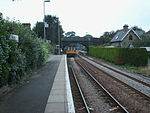Thunder Bridge
Bridges in West YorkshireGrade II listed buildings in West YorkshireHamlets in West YorkshireKirkburtonUse British English from June 2020 ... and 1 more
West Yorkshire geography stubs

Thunder Bridge or Thunderbridge is a hamlet and bridge in the civil parish of Kirkburton, in the Kirklees district, in the county of West Yorkshire, England. It is near the A629 road and Stocksmoor railway station. Its post town is Huddersfield. It has a pub called the Woodman Inn. The bridge is a Grade II listed building which is a road bridge over Shepley Dike.
Excerpt from the Wikipedia article Thunder Bridge (License: CC BY-SA 3.0, Authors, Images).Thunder Bridge
Dam Hill, Kirklees
Geographical coordinates (GPS) Address Nearby Places Show on map
Geographical coordinates (GPS)
| Latitude | Longitude |
|---|---|
| N 53.598954 ° | E -1.716688 ° |
Address
Dam Hill
Dam Hill
HD8 0GF Kirklees
England, United Kingdom
Open on Google Maps







